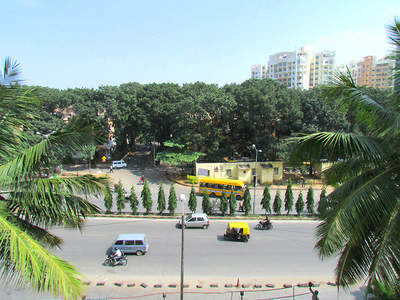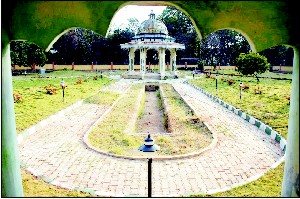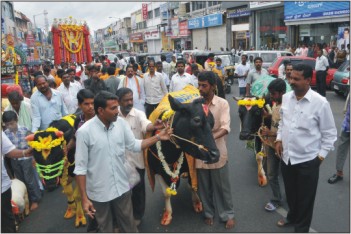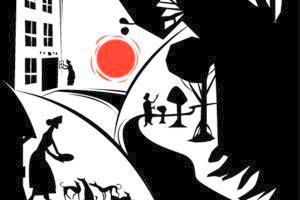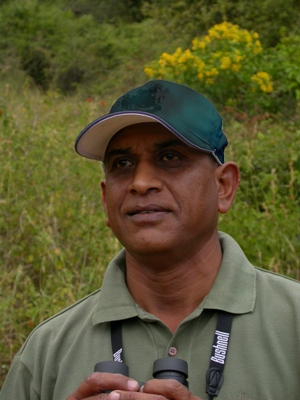 PRESERVING TRADITION: Gurusamy with his collection of native seed varieties. Photo: M.J. Prabu / The Hindu
PRESERVING TRADITION: Gurusamy with his collection of native seed varieties. Photo: M.J. Prabu / The Hindu
Farmers like Gurusamy have been reaching out to their community
Inside a dingy and dark room of a house at Odayarpalayam village in Karnataka’s Chamrajnagar district, old earthen pots and worn-out plastic jars are lined up on ramshackle wooden shelves. Inside them are colourful beads and seeds, labelled neatly.
These are native seeds, painstakingly collected and documented by Gurusamy, a traditional seed collector and farmer, who has been in the business for the past 10 years.
P. Rajachar, Programme Officer of the Mysore Resettlement and Development Agency (Myrada), says that thanks to Mr. Gurusamy’s efforts, hundreds of varieties of native seeds have been collected and distributed to farmers. These varieties are now grown on nearly 25 acres.
“I think there are more than 3,000 farmers in Karnataka who grow and maintain such seed varieties. We’ve a good network of suppliers who see to it that our bank balance [read seed bank] doesn’t go down,” adds the self-effacing farmer, who has sustained his efforts creditably.
His suppliers are mainly farmers who want to grow native varieties. “Mostly my suppliers are growers who are eager to preserve native varieties. While supplying seeds, I reach an informal agreement with them to give me back a portion of the seeds after the harvest,” says Mr. Gurusamy.
Seeds, symbols of fertility and vitality, have been a part of Indian culture and heritage for long; to a farmer they personify self-respect. In fact, long before hybrid seed companies set up shop and went commercial, the traditional farmer had saved his own seeds, swapped them with neighbours or exchanged them with others.
Mr. Gurusamy said:
“Sadly, this intimate knowledge of the farmer and his traditional wisdom have been systematically devalued by several scientists, who are keen to promote technologies and seeds that are not suited to a particular area or community.
“High-yielding seed varieties and chemical fertilizers and pesticides that came with the Green Revolution destroyed several indigenous seed varieties. As farmers stopped saving and exchanging seeds, and instead started buying them from the market, their native expertise became irrelevant and crop diversity suffered. In a land that once had several thousand varieties of crops, most of them are no more to be found.
“Farmers used to grow these, swap them with neighbours and preserve them for tough times. These seeds have beaten several odds. In fact, even today we’re able to hold out against the multinational seed companies that are trying to dislodge us and our collection.
“I normally do not charge for the seeds if the farmer desires to grow it in a small area, say, in his backyard. I simply request him to return a small portion of the seeds. But for those growing the crop on four to 10 acres, I charge a nominal amount. It could be anything between Rs. 5 to Rs. 20, depending on the seed one wants.”
There are four persons who help Mr. Gurusamy in his work. They go to various places in Karnataka and Tamil Nadu to source seeds, and update and maintain a database of native growers.
“Like Mr. Gurusamy, C. Rudriah from Kadambur, C. Palaniammal from Bargur, V. Narayanan from Kottamallan, D. Mahesh from Kadatti, N. Alamma from Kottarai and B. Ambamani from Hongalvadi are some of the farmers who preserve and supply native seeds,” says Mr. Rajachar.
These people are simple farmers who cultivate on their meagre holdings. It is their interest in protecting local and native seed varieties that has turned them into seed saviours.
Mr. Gurusamy’s phone number is 09008167819; Mr. Rajachar’s is 09449203217.
source: http://www.TheHindu.com / Home> S&T> Agriculture / by M. J. Prabu / Chamrajnagar, May 02nd, 2012
